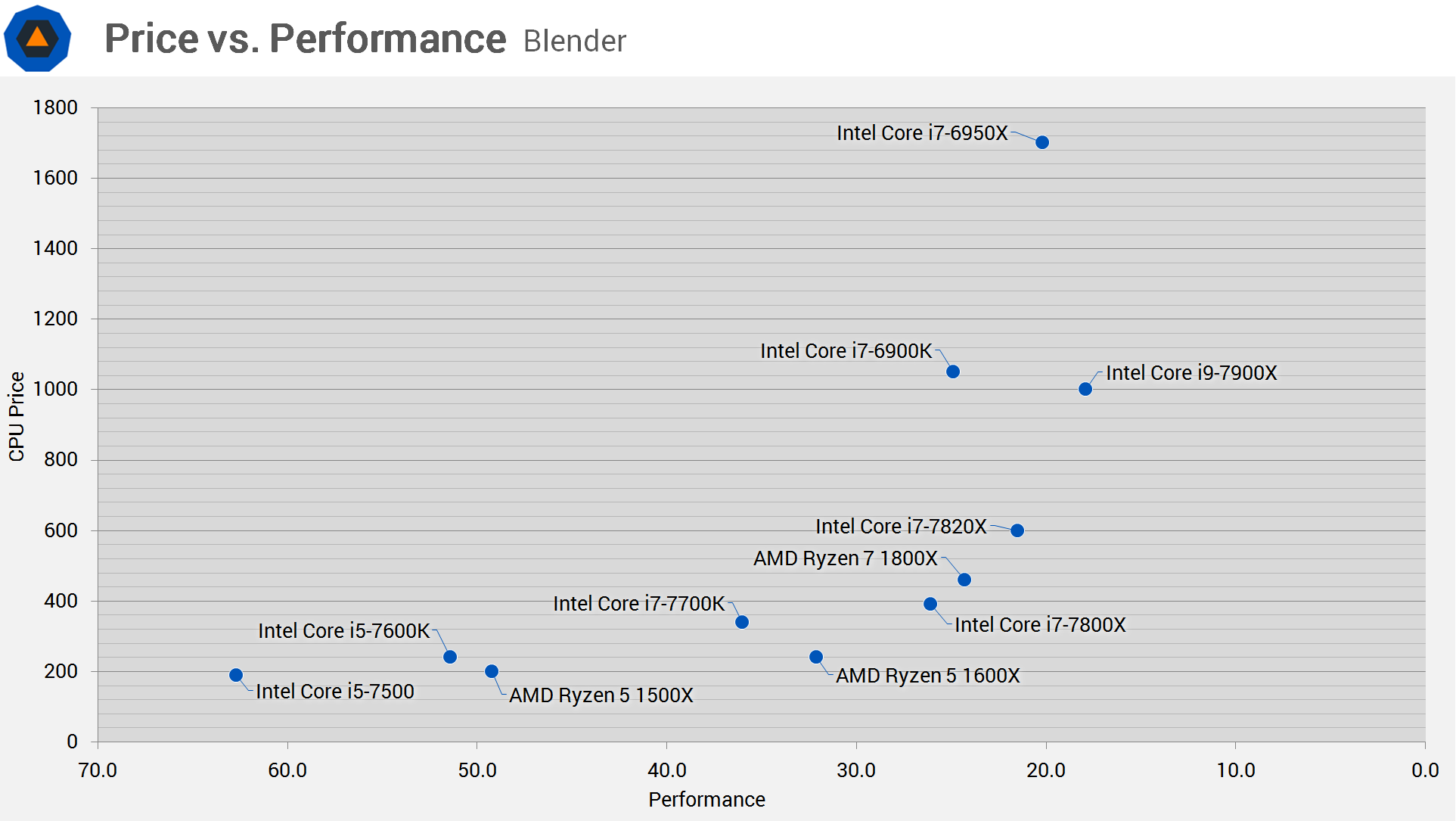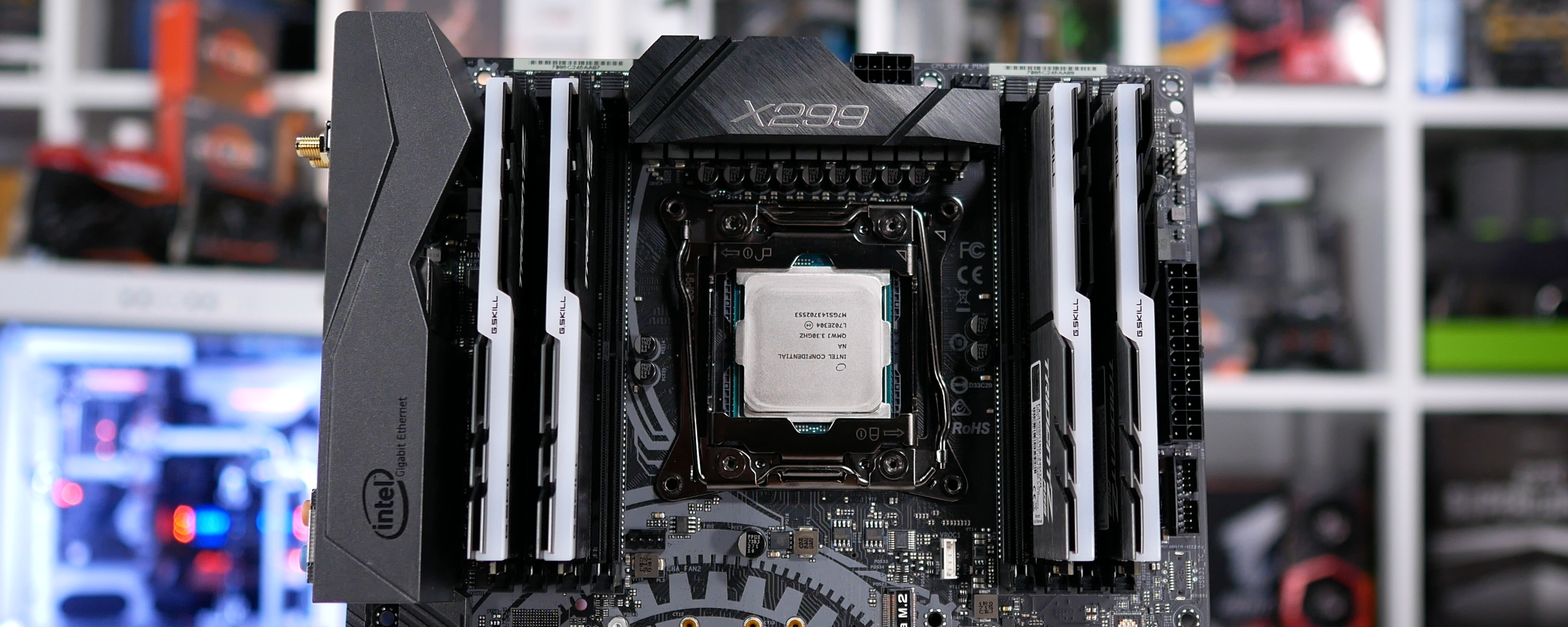Analysis: Price vs. Performance and Takeaways
Before jumping to conclusions, let's try putting our results into perspective with a price vs. performance scatter plot for the Cinebench R15 multi-threaded results. Ideally, for all the price vs. performance graphs here you want the CPU to be as far right as possible and as low as possible, the further right the better the performance and the lower the better the price.

As you can see, the Ryzen 7 1800X is rather far right and still quite low, looking a bit better than the Core i7-7800X in terms of value. Remember, the 1800X itself isn't a particularly good value sitting next to the Ryzen 7 1700, which sadly we didn't have time to add to this review but will in future articles.
Compared to the 6950X, the new 7900X is a massive step forward in terms of value offering much greater performance at a much better price.

Moving to the Blender results we again see that the Ryzen 7 1800X and Core i7-7800X are similar in terms of value, though again the pesky Ryzen 7 1700 will mess things up for Intel here. Anyone looking strictly at Intel's line-up will see that the 7900X is a huge leap forwards, priced alongside the 6900K it offers significantly better performance in this application.

The Core i9-7900X proves a very significant upgrade over Broadwell-E in our Handbrake test. For the same money you're essentially getting a 50% boost in performance, I believe the increased memory bandwidth really helped here. Meanwhile the Ryzen 7 1800X finds itself situated between the 7800X and 7820X in terms of price and performance.

The Corona price vs performance figures look particularly impressive for the Ryzen 5 1600X as it sneaks in just behind the Core i7-7800X at a much lower price. Meanwhile, the 1800X is much closer to the 7820X while again coming in at a lower price.

For 7-Zip I have only looked the decompression results and AMD does much better here when compared to the compression testing. That said, I feel most of you will do significantly more decompression work than compression and as you can see for decompression, the 1800X is a lot better value than the Core i7-7800X and 7820X processors.

Looking at the PCMark rendering and visualization figures we see that the Core i9-7900X is a massive upgrade over what Intel was previously offering, but for less than half the price the Ryzen 7 1800X isn't much slower and in terms of value it also gives the 7820X and 7800X a hard time.

Lastly we have the Premiere Pro CC results and here the scatter plot looks quite a bit different to those seen previously as this application doesn't really do a good job of utilizing the higher core count CPUs. Even so, the 7900X does still offer a decent increase in value over the 6900K.
Conclusion
I think we can all agree that Skylake-X offers mighty impressive performance. The Core i9-7900X blows everything else out of the water and the 7820X does a good job of making Intel's previous-generation 8-core CPU look a little sluggish. Single and dual-thread performance is great, roughly on par with the best quad-core CPUs.
After testing Intel's new 6-, 8- and 10-core parts, we're keen to check out the pricier 12, 14, 16 and 18-core editions later this year, but let's not worry about those for now.
Power consumption appears to be the only hiccup for these chips, which burned between 20 and 40% more power than the equivalent Broadwell-E parts – pretty brutal.
Although I haven't delved too deep into overclocking yet, based on what I've seen so far I wouldn't get my hopes up, and if go-to AIO liquid coolers aren't cutting it, serious custom loops will be required.
To recap: performance is good and power consumption is scary, but what about the price?
Compared to Broadwell-E, Skylake-X is a far better value. We've gone from $1,700 for Intel's exclusive 10-core chip to $1,000, and in the process we're getting a much faster processor, albeit a hungrier and hotter one, too.
The Core i9-7900X is still seriously expensive, but with no competition in front of it, Intel can get away with that for now. ThreadRipper will likely change that soon, which is a relief to say after so many years, but that will be a story for another day.
Let's talk 8-core CPUs for a minute. The Ryzen 7 1800X costs $460, but smart shoppers will opt for the much cheaper $310 1700, which can be overclocked to achieve the same performance. The Core i7-7820X comes in at $600, making it 30% more expensive than the 1800X, but almost twice the price of the 1700.
However looking at the real-world applications, the 7820X was on average just 10% faster. The 7820X does have the advantage of 28 PCIe 3.0 lanes versus 16 for the Ryzen 7 CPUs. Although this is something ThreadRipper will address, for the time being the 7820X is the obvious choice if you need the extra lanes.
If all you care about is value, Ryzen 7 is the obvious option as decent X370 boards start at $110, making the CPU and motherboard combo just $420 if you intelligently opt for the R7 1700. Comparatively, the 7820X and the cheapest X299 board will set you back $830, basically twice the price for nowhere near twice the performance.
Likewise, the 6-core 7800X roughly equals the 1800X in terms of performance. If you throw the R7 1700 into the mix, even Intel's most affordable Skylake-X CPU is a tough sell.
Now, if you don't care about value, the Core i9 7900X is the way to go. Its performance is exceptional, you get loads of PCIe lanes, overclocking is an option to some degree (quite a few degrees in fact) and the X299 platform is superior to AMD's X370. But if you can wait a couple of months, my advice is to hold out and see what AMD has to offer with and then go from there – if nothing else, Intel might have to adjust pricing.
Shopping shortcuts:
- Intel Core i9-7900X on Amazon, Newegg
- Asrock X299 Taichi motherboard on Newegg
- Intel Core i7-7820X on Amazon, Newegg
- Intel Core i7-7800X on Amazon, Newegg
score
Pros: Skylake-X topped our performance charts, bringing a much better value over Broadwell-E on the high-end.
Cons: It's extremely power hungry and considerably more expensive than Ryzen equivalents.



